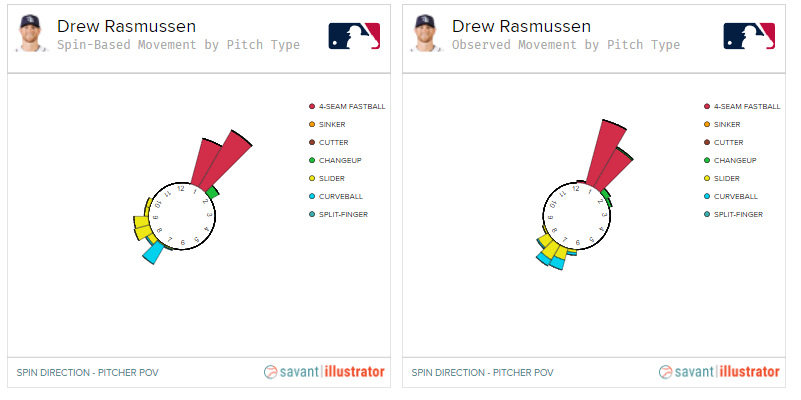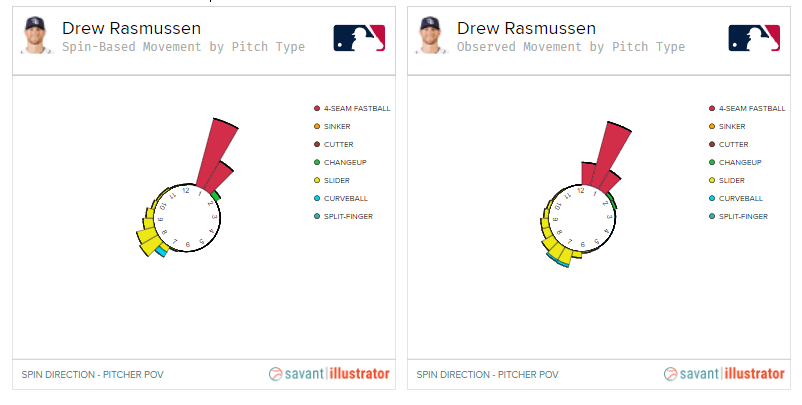Drew Rasmussen Made Sweeping Changes to His Slider

Drew Rasmussen was a Rays success story last year. A key part of the trade that sent Willy Adames to Milwaukee, Rasmussen profiled as a plus reliever. But after initially serving as a multi-inning bullpen arm, Tampa Bay slotted him into the rotation for the last two months of the season, and he delivered 37 innings of 1.46 ERA, 2.76 FIP excellence. Sure, it was over 4.5 innings per start, and the peripherals weren’t pretty, but quality over quantity has always been a deal the Rays will take, and you certainly can’t argue with his run prevention.
Rasmussen did it despite what could charitably be described as a predictable arsenal. He threw his fastball 65% of the time and his slider another 30% of the time. If we’re being honest, it was more like 1.5 pitches — his fastball did a lot of the heavy lifting, and the slider picked up the pieces. It’s one of those spin-and-speed four-seamers that are all the rage these days. Rasmussen didn’t always locate it well, but simply put, it’s a hard pitch to hit.
He paired that fastball with a slider that featured two-plane action. It wasn’t a big movement pitch; it had drop and arm-side run in roughly equal proportion, but its main standout quality was that it was an offspeed pitch when hitters were setting up for 98 mph at the letters. If you’re trying to cover a high fastball, particularly one that struck you out last at-bat like this:
Then it’s hard to adjust to a slow and low pitch like this:
When you look at it that way, it’s a pretty good pitch. And hey, by some metrics, it was: hitters had a lot of trouble squaring it up, mustering a woeful .226 wOBA on contact (and a 41% hard-hit rate). On the other hand, it hardly missed any bats; Rasmussen was in the bottom 10% of baseball for swinging strike rate and bottom 15% for CSW rate. Eno Sarris wrote about the pitch in the playoffs and came away similarly unsure of its efficacy.
Breaking news: Rasmussen himself wasn’t enamored with his slider. Even during the season, he’d begun tinkering with it, as Cole Mitchem detailed in a look at Tampa Bay’s slider philosophy. In Milwaukee, his slider averaged 2.4 inches of horizontal movement per Brooks Baseball. In his last three outings with Tampa Bay, it averaged 4.5 inches of horizontal break. Don’t focus too much on the numbers – Brooks uses a different standard for its measurements. Focus instead on the fact that he doubled the pitch’s horizontal break in-season.
It would be easy to lose that late-season adjustment in the full-year numbers, which showed a slider with middling horizontal movement. But this season, Rasmussen came out with the pure sweeping slider that the Dodgers and Rays have been emphasizing of late (the Yankees have been as well, only they call it a “whirly” in an attempt to make baseball as incomprehensible as possible).
Want to see it in graphical form? Baseball Savant has a delightful feature that lets you see the release spin (as well as eventual movement) of a pitcher’s entire arsenal. Here’s Rasmussen in 2020:

Note the sliders in yellow. He released them at a consistent angle, they consistently picked up some downward movement in their path home, and they were clustered around 7:00 on the clock face in their observed movement.
Next, 2021:

The fastball looks mostly unchanged, but he released his slider all over the place, and the shape of its movement varied just as much. That’s because he kept changing sliders as the year went on.
Finally, 2022:

It’s only been one game, but now his slider is an archetypical sweeper. It comes out of his hand with an angle roughly mirroring his fastball, but that profile changes meaningfully on its way home; it ends up with mostly horizontal movement, 8:30 on the clock face on average. It’s not exactly the same, but think Blake Treinen’s frisbee slider if you’re looking for a pitch comparison.
There’s another interesting development in that chart: Rasmussen has added a cutter to diversify his offerings. I’m not convinced that it’s a keeper; more than anything, it looks like a nice change of pace from his fastball. It comes out of his hand similarly but falls an additional 15 inches on its path home. That sounds like a recipe for grounders and soft contact, but it could also be a recipe for home runs depending on his ability to locate it. So far, he’s mainly thrown it to the glove-side edge, but uh, don’t leave this pitch middle-middle if you can help it:
Regardless of what he does with the cutter, though, Rasmussen’s new slider is here to stay. It was more novel than dominant in his first start of the season. The movement was nice, and he did a good job of locating it near but off the plate to his glove side, but the Orioles mostly took those tough pitches. He ended up with only a single swinging strike, though it was a pretty one:
Is a devastating fastball and a trendy breaking pitch enough to keep hitters off-balance? If they aren’t, will his cutter make the difference? I’m not sure. He didn’t look overwhelming in his first start of the year, and that was against the Orioles. We’ll learn more when he makes his next turn, currently scheduled for this Thursday against the A’s. I’m not sold that Rasmussen will work out as a starter; his pitch mix just feels like that of a dominant closer to me, and a baby cutter isn’t enough to change my mind there.
The Rays have used him as a hybrid so far. He’s rarely faced a single batter three times in a game; only six of the 258 batters he’s faced as a Ray came the third time through the lineup. That works out to a 3-5 inning start most of the time, an output that looks equally at home after an opener or before a reliever parade. It would look excellent split into two chunks of two innings across a few outings, though, as a high-leverage multi-inning reliever. The Tampa Bay pitching staff is confusing that way.
My suggestion? Put all of that out of your mind for now and just see what develops. Rasmussen’s long-term role in the majors is just as confusing as it was last year. The way he pitches, though? It’s changed significantly since he came over from Milwaukee, and if the other slider merchants in Tampa Bay are any indication, batters are going to struggle with the new Rasmussen sweeper, regardless of what role he settles into.
Ben is a writer at FanGraphs. He can be found on Bluesky @benclemens.

Do all of his sliders look like that? Because if they do, then it’s pretty awesome. He’s still probably a closer rather than a starter, but that sweeper, uh, sweeps.
Here’s all of them via Savant: https://atmlb.com/3xr2f6H
That one was particularly nasty but the east/west movement is real